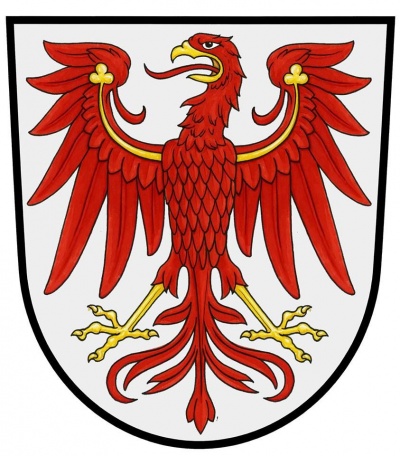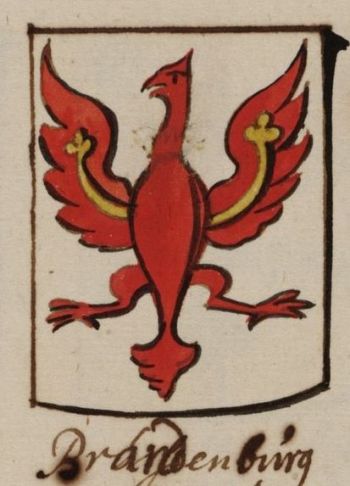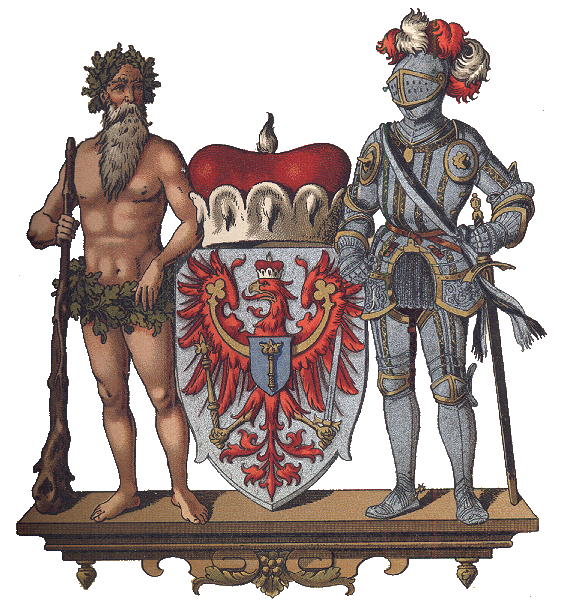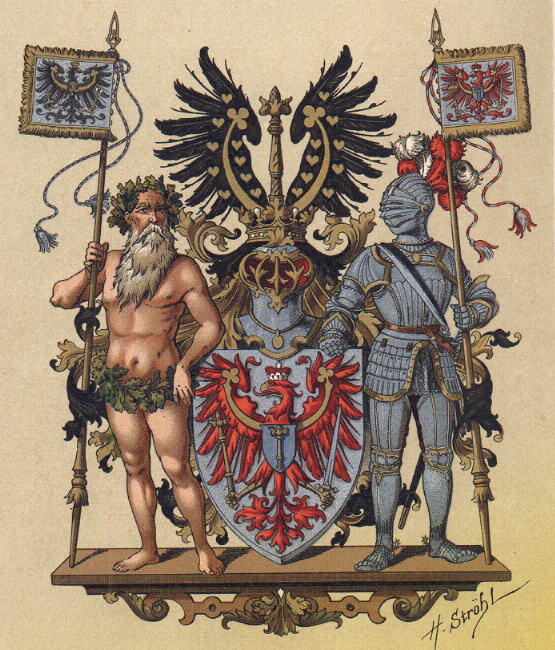Brandenburg: Difference between revisions
Knorrepoes (talk | contribs) m (Text replacement - "===Official blazon=== (de)" to "===Official blazon=== *(de)") |
Knorrepoes (talk | contribs) m (Text replacement - "]]:S" to "]]: S") Tag: Manual revert |
||
| (20 intermediate revisions by the same user not shown) | |||
| Line 1: | Line 1: | ||
'''BRANDENBURG''' | '''BRANDENBURG''' | ||
[[File:brandenburgstate.jpg|center|400 px|Wappen von {{PAGENAME}}]] | [[File:brandenburgstate.jpg|center|400 px|Wappen von {{PAGENAME}}/Coat of arms (crest) of {{PAGENAME}}]] | ||
{| class="wikitable" | |||
|+Official blazon | |||
|- | |||
|'''German''' | |||
| blazon wanted | |||
|- | |||
|'''English''' | |||
| blazon wanted | |||
|} | |||
===Origin/meaning=== | ===Origin/meaning=== | ||
The arms were officially adopted on January 30, 1991. | The arms were officially adopted on January 30, 1991. | ||
| Line 14: | Line 21: | ||
In 1417 Friedrich VI of Hohenzollern, Count of Nürnberg, was appointed Margrave of Brandenburg on the Concilium of Konstanz by Emperor Sigismund. The Emperor also gave him a sceptre as a symbol for his new territory. He used this sceptre in his personal arms in gold on blue, but it was not used widely in the arms of the territory itself. Only in 1864 the sceptre was added as a breast-shield on the eagle. | In 1417 Friedrich VI of Hohenzollern, Count of Nürnberg, was appointed Margrave of Brandenburg on the Concilium of Konstanz by Emperor Sigismund. The Emperor also gave him a sceptre as a symbol for his new territory. He used this sceptre in his personal arms in gold on blue, but it was not used widely in the arms of the territory itself. Only in 1864 the sceptre was added as a breast-shield on the eagle. | ||
{|align="center" | |||
|align="center"|[[File:{{PAGENAME}}.hes.jpg|350 px|center|Coat of arms (crest) of {{PAGENAME}}]]<br/>The arms in the [[Wapen- en Vlaggenboek Hesman|Wapen- en Vlaggenboek]] van Gerrit Hesman (1708) | |||
|} | |||
These arms were continued until 1945 by the Prussian '''Province of Brandenburg'''. The province used three types of arms, as shown below. | These arms were continued until 1945 by the Prussian '''Province of Brandenburg'''. The province used three types of arms, as shown below. | ||
{|align="center" | {|align="center" | ||
|align="center"|[[File:branden2.jpg|center|Wappen von {{PAGENAME}}]] <br/>The small arms of the Prussian province Brandenburg | |align="center"|[[File:branden2.jpg|center|Wappen von {{PAGENAME}}/Coat of arms (crest) of {{PAGENAME}}]] <br/>The small arms of the Prussian province Brandenburg | ||
|- | |- | ||
|align="center"|[[File:branden3.jpg|center|Wappen von {{PAGENAME}}]] <br/>The middle arms of the Prussian province Brandenburg | |align="center"|[[File:branden3.jpg|center|Wappen von {{PAGENAME}}/Coat of arms (crest) of {{PAGENAME}}]] <br/>The middle arms of the Prussian province Brandenburg | ||
|- | |- | ||
|align="center"|[[File:branden4.jpg|center|Wappen von {{PAGENAME}}]] <br/>The large arms of the Prussian province Brandenburg | |align="center"|[[File:branden4.jpg|center|Wappen von {{PAGENAME}}/Coat of arms (crest) of {{PAGENAME}}]] <br/>The large arms of the Prussian province Brandenburg | ||
|} | |} | ||
From 1945-1991 the territory had no official arms. | From 1945-1991 the territory had no official arms. | ||
{{de}} | |||
{{media}} | {{media}} | ||
[[Civic Heraldry Literature - Germany|Literature]] : Ströhl, 1897; Schurdel, 1995 | [[Civic Heraldry Literature - Germany|'''Literature''']]: Ströhl, 1897; Schurdel, 1995 | ||
[[Category:German States]] | [[Category:German States]] | ||
[[Category:Brandenburg]] | |||
[[Category:Granted 1991]] | [[Category:Granted 1991]] | ||
Latest revision as of 05:41, 13 August 2024
BRANDENBURG
| German | blazon wanted |
| English | blazon wanted |
Origin/meaning
The arms were officially adopted on January 30, 1991.
The arms are the old arms of the Counts of Brandenburg, which was also used by the County of Brandenburg and the later Prussian province of Brandenburg.
In 1134 King Konrad III appointed Albrecht the Bear of the Ascanier dynasty as vassal of the Nordmark. In 1150 he inherited the Havelland area, including the city of Brandenburg. Since 1157 he used the title Markgraf (Margrave) of Brandenburg, a title which was continued by his successors, also from other dynasties. Albrechts son, Otto I, first used the eagle in his seal around 1170. The eagle was derived from the German Imperial eagle, as the area was still a loan from the German Emperors. The colours were probably taken as canting, Brand meaning fire. When the golden trefoils on the wings were added is not quite clear, but most likely already in the 13th century.
In 1417 Friedrich VI of Hohenzollern, Count of Nürnberg, was appointed Margrave of Brandenburg on the Concilium of Konstanz by Emperor Sigismund. The Emperor also gave him a sceptre as a symbol for his new territory. He used this sceptre in his personal arms in gold on blue, but it was not used widely in the arms of the territory itself. Only in 1864 the sceptre was added as a breast-shield on the eagle.
The arms in the Wapen- en Vlaggenboek van Gerrit Hesman (1708) |
These arms were continued until 1945 by the Prussian Province of Brandenburg. The province used three types of arms, as shown below.
| The small arms of the Prussian province Brandenburg |
| The middle arms of the Prussian province Brandenburg |
| The large arms of the Prussian province Brandenburg |
From 1945-1991 the territory had no official arms.
This page is part of the German heraldry portal Deutsche Wappensammlung |
Heraldry of the World |
|
German heraldry:
|
Selected collector's items from Germany:
|
Contact and Support
Partners:
Your logo here ?
Contact us
© since 1995, Heraldry of the World, Ralf Hartemink 
Index of the site
Literature: Ströhl, 1897; Schurdel, 1995
















